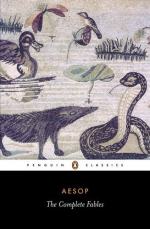|
This section contains 901 words (approx. 3 pages at 400 words per page) |

|
Point of View
Each fable is told from the point of view of an omniscient narrator. The narrator, presumed to be Aesop, tells the fables the way one would tell a joke at a bar or a party. Each tale shows wit and insight into the nature of its characters. Animals and inanimate objects have a voice. In fable 101, a bramble and a fir tree insult each other. In fable 257, a plane tree takes umbrage with the insults of two men resting in its shade. In fable 214, a mulberry tree passes judgment on a murderer.
The gods, highest of all beings, humanized in their vanities and foibles, become mere characters rather than high deities. In fable 108, Hermes falls victim to his own vanity when trying to buy a statue of himself. In fable 4, Zeus, king of the gods, is tricked into betraying his consecrated eagle by a small scarab...
|
This section contains 901 words (approx. 3 pages at 400 words per page) |

|




